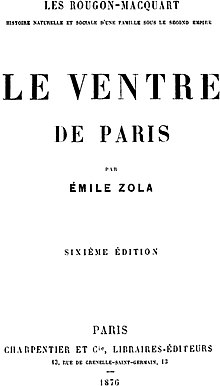The belly of Paris
The belly of Paris ( French : Le Ventre de Paris ) is a 1873 novel by Émile Zola and the third part of the twenty-volume Rougon-Macquart cycle . The action takes place mostly on the central market of Les Halles of Paris . The market halls built during the second empire with their glass and steel construction are presented as milestones in progress. Zola describes the retail environment and deals for the first time with the realities of the working class.
action
The main character is Florent, who was arrested during the coup d'état of 1851 , innocently sent to a penal colony and who finally managed to escape.
The action begins with his return to Paris. He finds accommodation with his brother Quenu and his wife Lisa, who run a butcher shop together. Especially at Lisa's request, he takes a job as an inspector in the fish halls. Florent develops into the leader of a circle that amateurishly plans an uprising to restore the republic. Florent teaches the son of a fishmonger, the beautiful Normande, reading and writing. She seeks a liaison with him, but Florent does not agree. An enmity arises between the beautiful Normande and Lisa Quenu. Florent gets caught between the fronts. Eventually he and his co-conspirator Gavard are arrested.
At the end the reader learns that many people around him denounced Florent independently of one another, including a. his brother's wife, the Normande and a member of the gang of conspirators. The painter Claude Lantier, hero of the later novel Das Werk , takes on the role of a passive observer. The novel is rich in Impressionist accounts, of which that of a cheese shop is the most famous. This passage is known as the "cheese symphony":


- The cheese stank around the three of them. In the background, huge lumps of butter lined up on the two boards of the shop: butter from Brittany in baskets overflowed; the Normandy butter wrapped in canvas resembled the first drafts of bellies over which a sculptor threw damp cloths; other lumps, torn and cut with broad knives into sharp rocks full of valleys and fractures, looked like sunken peaks, gilded with the pallor of an autumn evening. Under the display table made of red, gray-veined marble, egg baskets placed a chalk white; and in boxes, the bondons, placed close together on straw hurdles, and the Gournay cheeses, arranged flat like medals, formed darker surfaces dotted with greenish tones. But most of all, the cheeses piled up on the table. A huge Auvergner cheese, split as it were by ax cuts, spread out next to pound pieces of butter in beech leaves; Then came a gold-colored Chester cheese, a Swiss cheese that resembled a wheel that had fallen off a barbarian vehicle, and Edam cheese, round like severed heads, smeared with dried blood and hard as hollow skulls, which is why they are called skulls. A Parmesan cheese brought its pinch of aromatic fragrance to this heavy cooked porridge. Three bries on round boards had the melancholy of dull moons; two that were very dry formed full moons; the third was in the second quarter and was running, emptying the white cream that had spread to a lake and tore the thin boards that had tried in vain to hold it together. Port saluts, which resembled ancient discus discs, had the names of the manufacturers printed on them as an inscription. A Romadur clad in his silver paper conveyed the illusion of a stick of nougat, a sugared cheese that had got lost among these pungent fermentations. The Roqueforts under their crystal bells also had princely expressions, mormorous and fat, blue and yellow-veined faces, attacked as it were by a nefarious disease of rich people who have eaten too much truffles, while hard, light gray goat's cheese the size of a child's fist is on them in a bowl Pebbles were a reminder that the goats, when leading their flock, set them rolling at the bends in the stony paths. Then the smelly cheeses began: the pale yellow, sweet-smelling Mont-d'or cheeses; the very thick Troyes cheeses, squeezed at the edges, already more spicy, which added a damp cellar smell; the Camemberts with their strong scent, venison that has hung too long; the square Neufchâteller, Limburger, Marolles and Pont-l'Evêques each brought their garish and special note in this tart tonal setting that was up to nausea; the Livarots, colored red and dreadful in their throats like sulfur vapor; Finally, above all the others, the olivets, which were wrapped in walnut leaves like the carrion steaming in the sun, which the farmers cover with branches at the edge of a field. The hot afternoon had softened the cheese. The mold of the bark melted, covered with the lush tones of red copper and verdigris like badly closed wounds. Under the oak leaves a breath lifted the skin of the olivets, which beat like a breast in the slow, long breathing of a sleeping man. A surge of life had riddled a Livarot, who through this notch gave birth to a people of maggots. And behind the scales, a Géromé spiced with anise in its thin box exuded such contamination that flies had fallen on the gray-veined red marble around it.
- (Translation by Felix Loesch and Hans Balzer, published by Rütten & Loening, Berlin)

